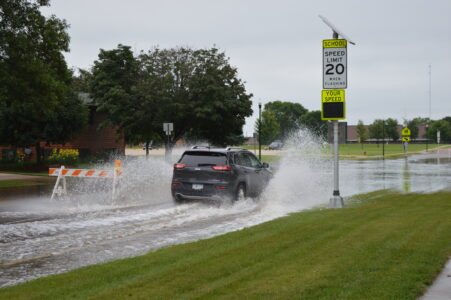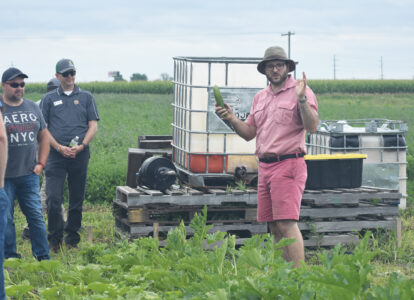Brandon’s Law one step in helping families in the future
MARSHALL – Like Patty and Jerry Wetterling, Marc Klaas, John Walsh and countless others who have suffered terrible tragedies and somehow found the courage to create positive change for children in the world, Brian and Annette Swanson have fought to implement change for all missing persons regardless of their age.
The Swansons, who live in Marshall, were instrumental in getting “Brandon’s Law” passed in Minnesota in 2009. The law is named in honor of their 19-year-old son Brandon, who went missing in rural Taunton on May 14, 2008.
“There had been a lot of work done with children, which is great, but when our children become adult children – because we’re all somebody’s child – there wasn’t as much protection or help for families with adult children situations,” Annette said. “It shouldn’t matter whether your child is 18, 25 or 30.”
Before Brandon’s Law went into effect, law enforcement agencies were not immediately required to take a missing adult report or begin an investigation.
“You had to wait so many hours before you could even report them missing, so that was a big hurdle, a big obstacle,”?Annette said. “As adults, we have a greater capacity to fend for ourselves, to rationalize and to process information than children do. But when you’re in a situation, whether it’s life or death, dire circumstances or whatever, time is always of the essence.”
Brandon was returning to his home in Marshall after visiting college friends in Canby – where he had just completed his second semester of classes in the wind energy program – when his car got stuck along a ditch. After contacting his parents to ask for a ride, Brandon got out of his vehicle and began walking, continuing to talk to his dad via cell phone. Forty-five minutes later, Brandon said a single curse word before his cell phone abruptly went dead, leaving loved ones and investigators to wonder what happened to him.
Despite extensive searches, no trace of Brandon, his cell phone, clothing or jewelry have ever been found on land or in the nearby Yellow Medicine River.
“They call it ambiguous loss, the not-knowing where a loved one is,” Annette said. “You’re left in a constant state of searching, whether it’s searching your mind, searching your heart, searching your soul or searching a physical location. It’s brutal.”
BRANDON’S LAW AND ITS IMPACT
After searching for their son the rest of the night, the Swansons said they tried to report their son missing just after sunrise. They were unprepared for the response they received.
“They said he had a right to be missing because he was an adult,” Annette said. “Later, we wondered if somebody had dropped the ball and so you start researching and checking into things. It wasn’t that law enforcement dropped the ball. There were some lapses in the process and in the laws.”
Brandon’s case was somewhat unique in that three counties were involved, leading to questions over which had jurisdiction.
“Brandon’s car was in Lyon County, but Lincoln County was literally the other side of the road,” Brian said. “And then at the intersection about a fourth or a third of a mile away, that was Yellow Medicine County, which was also his last known location. So it was frustrating.”
As parents, the Swansons just wanted someone, anyone, to help them find their missing son.
Brandon’s Law, signed into law by former Gov. Tim Pawlenty on May 7, 2009, not only clarifies which agency will be the lead in an investigation, it also requires law enforcement to take a missing persons report without delay after notification of someone missing under dangerous circumstances, regardless of the person’s age. In addition, law enforcement must immediately begin an investigation.
“With Brandon’s Law, age has totally been taken off the table,” Annette said.
The Swansons worked with then-House Representative Marty Seifert to make change at the legislative level.
Though it is too late to help with Brandon’s case, Brian said there is some comfort in knowing that the new law will help others in the future.
“(Law enforcement and others) told us it would never go through,” Brian said. “But it was a good law, and it didn’t cost anything to the state to put this law into place, so that helped. It’s going to help other people, so you’re happy in that sense.”
PUTTING THE LAW INTO PLACE
After a hard-fought battle to get Brandon’s Law established, the Swansons knew there was still more to be done.
“For me, it was one challenge down, but the battle wasn’t over,” Annette said. “Just because it’s signed into law doesn’t mean it’s going to get put into place. Even though we’d been working with the players, the chiefs, sheriffs, the BCA (Bureau of Criminal Apprehension), they weren’t necessarily on board. The BCA was, but the others fought it to the end.”
The Swansons suspect that some law enforcement may feel as though extra missing persons reports are burdensome or costly, but they don’t believe that is actually the reality.
Annette recalls the transformation made by a Bloomington chief, who assisted on the policy and procedures committee, when he made a comparison between people and property.
“You could see he had this epiphany,” she said. “He said, ‘every time somebody calls in reporting a car stolen, no matter how many times this same car has been stolen, we take the report and we investigate it until we find the car and know whether it was stolen, misplaced or was parked somewhere else. But we always take this report of a stolen car. We should do that for people.'”
And from that moment on, the chief was fully on board.
The BCA now serves as the Minnesota missing persons clearinghouse. Before 2009, there was really no method to help connect the resources that were out there, Annette said.
After the passage of Brandon’s Law, law enforcement agencies are required to report and share investigation progress with the BCA, who is charged with making sure they have every available resource.
“The BCA is shouldering a lot of the load,” Annette said. “We worked really closely with them on the policies and procedures. Minnesota is lucky to have supportive people who have huge hearts.”
The BCA makes sure local agencies also collect valuable identifiers that can be added to current databases in the state and nation.
“The missing persons clearinghouse is going to follow back up with law enforcement and see where the case is at,” Annette said. “If it’s closed, then the case is closed. If not, have you collected identifiers – fingerprints, DNA, dental, X-rays – and if you have, where are they? Where have they been reported? They help with all those pieces.”
The Swansons said that law enforcement in the state have gradually started to understand the importance of Brandon’s Law, especially from a parent’s view. Changing the culture, the entire way people have been taught to view adults when they’re missing, takes time, Annette said.
“I think it’s happening,” she said. “They’re realizing that you’re not just talking about the life of the person you’re reporting. You’re talking about every single life that person has touched – their mother, their father, their siblings, their grandparents, their aunts and uncles, their cousins, their classmates, friends, co-workers and neighbors – it changes lives. It affects lives.”
THE NEED FOR AN ADVOCATE
While local law enforcement worked the case, the Swansons said they often felt isolated and left with more questions than answers. Despite knowing that law enforcement could not divulge many details in the investigation, they ached for information and regular contact with those who were searching for their son.
“We sort of felt lost,” Annette said. “And as we were going through this process, we felt it just had to be better. This is your child, so I think it’s normal to want to be hands-on.”
Without an advocate or liaison, they tried to find resources on their own. Over time, they sought out difference search organizations and later, the Jon Francis Foundation.
“Every family that has a missing person should be appointed an advocate or liaison to bridge that communication between law enforcement and the family, who just want answers,” Annette said. “You’re full of grief, shock and anger, so you’re not processing well anyway. Your ability to express yourself is also hindered. So to have an advocate to bridge that gap, in my opinion, is crucial. It would have been helpful in our case.”



